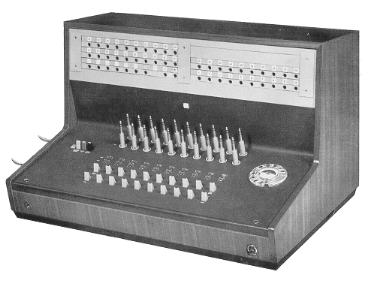|
PLESSEY SWITCHBOARD No. N171 | ||||||
| PRIVATE MANUAL BRANCH EXCHANGES Desk top, Cord-type Switchboard Type N 171 PMBX 7 + 40  This private manual branch exchange brings a new dimension to the field of
PMBX design. Sturdily constructed, yet superbly styled to complement the most
luxurious surroundings in offices and other business premises, it employs a new
Plessey component development - the cord-storage cassette - to present desk operation with
cord-switching simplicity. Matching this unique feature is the switchboard's capability to
accommodate a line capacity outside the
practical or economic limits of conventional desk designs. Seven exchange lines are
catered for, together with 10 cord circuits, and a basic 40 extensions, which may be
increased to 50 if needed. Lamp signalling is employed throughout. This private manual branch exchange brings a new dimension to the field of
PMBX design. Sturdily constructed, yet superbly styled to complement the most
luxurious surroundings in offices and other business premises, it employs a new
Plessey component development - the cord-storage cassette - to present desk operation with
cord-switching simplicity. Matching this unique feature is the switchboard's capability to
accommodate a line capacity outside the
practical or economic limits of conventional desk designs. Seven exchange lines are
catered for, together with 10 cord circuits, and a basic 40 extensions, which may be
increased to 50 if needed. Lamp signalling is employed throughout. Cord-storage Cassette Switchboard Construction General Features Ancillary jacks for ringing-supply, test and cord-test are provided; a neon lamp is associated with the former. The cord-test facility utilises the inserted plug's supervisory lamp as a fault indicator. A fuse alarm lamp is fitted adjacent to the ringing-supply neon, and the common-calling alarm pilot lamp is positioned centrally beneath the jack field. The jack strips used throughout are of a demountable design, enabling individual worn
jacks to be removed without disturbing "Call" and "answer" supervisory lamps, and two similarly associated
keys "speak/ring call" and "dial/ring back" are provided on each cord
circuit. The raising of the plugshelf on to its strut support gives ready access to wiring and components beneath, and does not require the breaking down of existing connections. Further calls can, in fact, be handled. Relays are Type 3000, mounted in detachable vertical strips. Access is via the rear door, which also serves to mount a fuse panel incorporating moulded alarm-type fuses. An elephant-grey operator's handset, supported on a fixed horizontal cradle, is provided
at the side of the switchboard, and connects into the circuit via the jack below the front
edge of the plugshelf. In addition, a matching lightweight headset can Operating Features Cord circuits apply an automatic hold to calling exchange lines when the "speak"
key is released; the hold is maintained until the
called extension answers. At termination, both supervisory lamps glow when the extension
replaces his handset-an action that immediately releases the exchange equipment. The
effectively metallic plug-to-plug connection, which provides for this feature, also
permits extensions to dial their own calls if desired. Direct-clearing on calls between
extensions, the associated supervisory lamp glows as each extension clears. Weight of Switchboard: 1081b (48.9kg) net. Extension lines are 2-wire Operating voltage is 50V d.c.. |
||||||
Last revised: November 14, 2020FM2 |